NVIDIA's GeForce 8800 (G80): GPUs Re-architected for DirectX 10
by Anand Lal Shimpi & Derek Wilson on November 8, 2006 6:01 PM EST- Posted in
- GPUs
The 680i Platform
Alongside the GeForce 8800 GTX and GTS, NVIDIA is launching a brand new chipset for Intel processors, the nForce 680i (and 650i SLI and Ultra). Our own Wesley Fink has published an in-depth look at the new chipset, but we felt the release significant enough to comment on some of its features here in this review.
For the most part, competing with Intel for its chipset business is an effort in futility. The companies that have tried have ended up either segregated to the low end of the market or kept to an extremely small niche. The past has proven that it is simply very difficult for a company that isn't Intel to produce a better performing chipset for Intel processors.
The multi-GPU era has changed things a bit, because now all of the sudden there's a new feature that Intel can't simply support on its chipsets. It took a while but ATI eventually allowed Intel to support CrossFire on its chipsets, but who knows how long that will last given ATI's new owner. While ATI caved in and supported Intel, NVIDIA would not capitulate. NVIDIA is like a mini-Intel and just like the big version, it doesn't play well with others. Licensing SLI for use on Intel chipsets was simply not in the cards; instead NVIDIA used SLI support as a reason for Intel users to consider NVIDIA chipsets. As NVIDIA continues to have the stronger multi-GPU lineup (although ATI has recently started fixing some of its problems with CrossFire), the SLI brand remains strong.
Although behaving like a veteran chipset manufacturer, NVIDIA is still a relative newcomer to the chipset business, but one thing we have seen from the boys in green is that they definitely learn from their mistakes. Dating back to the original nForce chipset, NVIDIA fell flat on its face with its first attempt at PC core logic, but bounced back to topple VIA with its nForce2 chipset. And it's that nForce to nForce2 transition that we're seeing here again with NVIDIA's nForce 680i SLI.
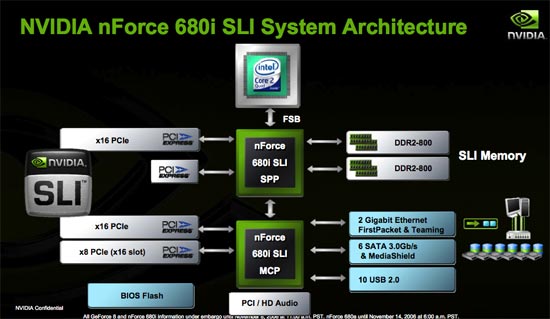
The 680i SLI is strictly a high end chipset, as the lower end of the market will still be serviced by NVIDIA's 570 SLI. The 680i supports all of the checkbox features: 1066MHz FSB (with unofficial support for higher speeds), dual channel DDR2-800, two PCIe x16 slots, one PCIe x8, 2 GbE ports, 6 SATA, 10 USB and HD Audio.
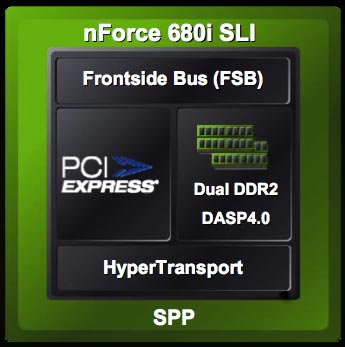
There are some pretty unique features about the new chipset. For starters it is the first NVIDIA core logic to be built on a 90nm process. The 680i SPP (aka North Bridge) is built on TSMC's 90nm process and thus ends up running cooler and can be overclocked more than NVIDIA's previous offerings in the area. The South Bridge (680i MCP) is still a 130nm chip but its functions are far less critical than those of the North Bridge.
In the 680i SPP is an updated version of NVIDIA's pre-fetching core called DASP. The major change to the 680i's DASP is that it is optimized for the memory access patterns of Conroe and Kentsfield which apparently are very different from NetBurst CPUs of the past. Given the aggressive prefetching done by the new Core processors and the large shared L2 cache, it isn't surprising to find out that memory controllers tuned to older Intel processors might not be best optimized for Core.
The primary function of the 680i's DASP is to examine memory access patterns and prefetch data into a local buffer that it thinks the processor will need at a later point in time. The updated version of DASP prefetches one cache line (64B) at a time into an internal buffer, although NVIDIA wouldn't disclose the size of the buffer.
We couldn't get much more information on DASP 4.0 from NVIDIA other than it supports prioritizing of reads over writes (to avoid read-to-write delays from random memory requests) and that a number of proprietary algorithms are used to make sure that prefetching doesn't occur when the CPU actually needs data from the memory controller.
Overclocking is a very large part of the new 680i chipset, and Wes' review of it goes into great detail about what exactly is possible with this new platform. For us, the other interesting part of the 680i platform is that, for the first time, NVIDIA is allowing its partners to sell NVIDIA engineered and designed 680i motherboards.
It has often been the case that a chipset maker's reference board has far more bells and whistles than anything its motherboard partners actually sell on the market. NVIDIA was growing weary of this being the case and instead effectively engineered a reference board that could be sold in retail.
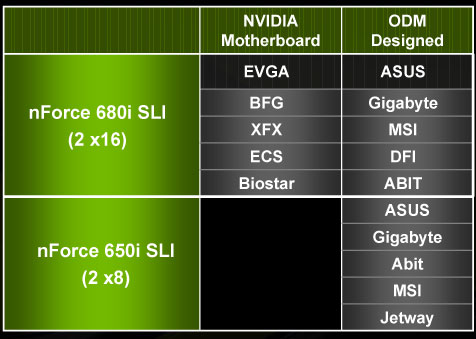
Motherboard makers can still choose to design their own 680i boards, but some have opted to simply rebrand NVIDIA's design.
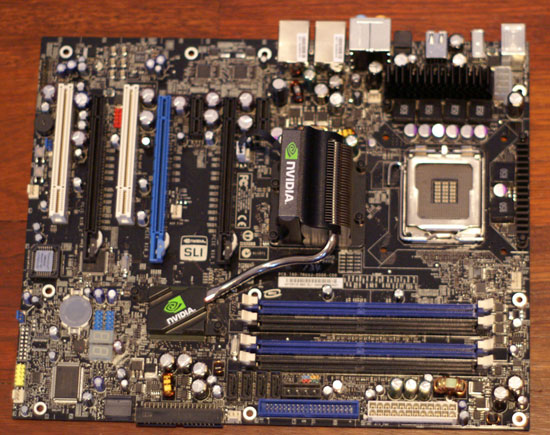
We ran all of our tests for this review on NVIDIA's nForce 680i SLI motherboard; this particular one is branded by EVGA. We were extremely pleased with the stability, BIOS, attention to detail and overall performance of the 680i solution. The decision to introduce NVIDIA designed 680i boards also shows how far NVIDIA has come as a manufacturer; if you want something done right, you sometimes have to do it yourself, and that's exactly what NVIDIA decided to do here. Honestly, the only downside is its estimated cost of $229.
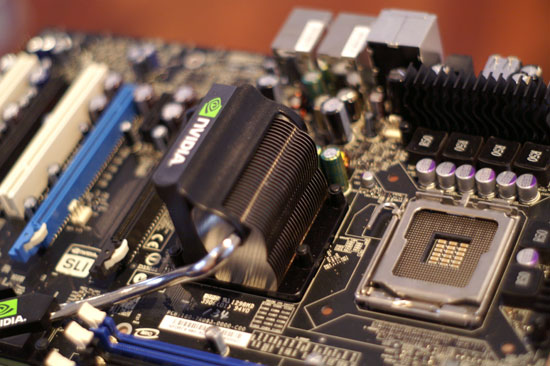

Three PCIe x16 slots (one is an x8 electrical)
NVIDIA is also introducing a lower cost 650i SLI chipset with only two x8 PCIe slots, but there will be no NVIDIA engineered boards available based on that chipset.










111 Comments
View All Comments
Sharky974 - Thursday, November 9, 2006 - link
The new features of DX10 stuff was captivating at first, but quickly grew tiresome and needlessly complex. The IQ comparisons the same thing, some simplicity is needed here. Tell us in a nutshell what looks better and why. The mouse over pictures are well nigh useless as well, and all look like crap. Whatever needs to be changed to get the IQ point across, needs to be changed already, I'm guessing 200 zoom is a problem for starters.Then who's bright idea was it to only test one resolution, through the whole article?
Then who's bright idea was it to dedicate just as many graphs as performance, one per game, to not only power draw, but the even more useless performance per watt? Meaning 66% of your data graphs, in an article about a paradign changin, long-anticipated, brand new GPU, are related to the power usage of the card. Are you electric workers monthly.com now?
I am very surprised more of the comments weren't negative, this review was a total failure.
And yeah, what's with all the non-standard resolution testing? All the big sites like H, Anand, and FS go round and round talking about the incredible depths they go to get the bottom of real world performance as it relates to the real world, average user, and then you guys use stupid resolution likes 1280X960 (FS uses that particular one), that nobody on earth uses, regularly! It's really, really stupid. Hell for that matter, nobody uses 1600X1200 or any non-LCD native res anymore either, yet those are all staples of any review, and so these "real world" articles aren't very real world at all. But that's somewhat of a tangent issue, and I actually dont mind a lot of different resolutions tested, just as long as the big common ones are hit (which is not always the case)
DerekWilson - Friday, November 10, 2006 - link
I'm always working on bringing down the complexity of my explainations. It's one of my weak points as a writer. It's difficult for me to take something and present it at a high level that doesn't reflect exactly what the thing is. Analogies are great -- I like them -- but I have a hard time using them because I can't ever think of analogies that are accurate enough.Any suggestions you have for helping me explain things completely, accurately, effectively, and (especially) in the most straight forward manner possible are very welcome.
As for the IQ comparisons -- these were much more simplified than I had intended (because Anand told me we couldn't do rollovers with 40 images on one page -- it would load too slow). This is our version of putting things in a nutshell. I could get to the point faster though --
IQ:
gamma correct aa is great for edges, but it causes problems with thin lines and transparency/adaptive AA making textures look mushy. transparency/adaptive aa are great but have a large performance hit -- except in 8800 which keeps these features playable and offers higher IQ. CSAA is great at brining higher AA levels to edges, but the loss of Z data at the sub-pixel level makes it less effective at solving the thin line problem than equivalent MSAA modes. The roll overs illustrate all this.
Thats as simple as I can make it -- I hope it helps.
We did not only test at one resolution -- In every game we tested at 1600x1200, 1920x1440, and 2560x1600. In oblivion we tested at 1280x1024 as well.
All our resolution data was in the last graph on each page -- resolution scaling. There are two graphs per page on performance. As you can see, at resolutions below 2560x1600, the 8800 GTX is almost over kill.
1600x1200 is a standard LCD panel resolution and has been for quite some time. It's actually quite affordable now as well. 1280x1024 (while popular) is often too low to matter in a high end performance analysis piece (and where it did matter we tested it). 1920x1440 is a 4:3 resolution that will give 1920x1200 panel owners a very good idea of performance (differnce is usually under 5% in many games). 2560x1600 is a standard resolution for 30" LCD panels.
I can understand being upset if you missed the performance data at other resolutions, but it seems like the rest of your complaints are that we put too much data in the article. I doubt this will change in the future, but is there anything else we could have done to make this article better? We are very willing to listen to feedback, especially on articles as big as this.
Thanks,
Derek Wilson
flexy - Friday, November 10, 2006 - link
>>>complaints are that we put too much data in the article. I doubt this will change in the future,
>>>
i doubt you can make it RIGHT for everyone...however i share the opinion w/ MOST that it is an excellent review. TOO much data is seldom bad, NOT on a site where you can expect geeks and nerds digging every bit of information :)
I remember times when reviews where FAR less detailed...and what can be better than going in-depth into AA/AF modi, showing their differnce in detail ? I think this was right on and i value such in-depth coverage !
The DX10 coverage MAYBE was "too much info" for some...but then legitimate IMHO. We're talking about totally new h/w architecture, totally new and revamped DX API and the first hardware supporting it..so it was defintly a good place to cover this.
Also...you always have the option to skip parts of a review...and the MORE detailed it is...the more it is a helpful resource (also later) to come back and read up. You dont need to comprehend any bit of information at once, but it's good to know it's there.
my $0.2
jiulemoigt - Thursday, November 9, 2006 - link
The first really big issue is that a poly can have more than one color on it, due textures, subsurface scattering, displacements, bump maps, normal maps, occulion passes, specular highlight, transparency, and a few others I can not think of off the top of my head, you could probaly find out just by asking in any cg forum like cgtalk or any dev who has worked with a profesional 3d package. That being said it may have confused people to try and explain how it really works.The other issue is to deal with gamma correct AA, maybe my moniter is showing a way different image but I'm not really sure how you can even compare
http://images.anandtech.com/reviews/video/NVIDIA/G...">http://images.anandtech.com/reviews/video/NVIDIA/G...
http://images.anandtech.com/reviews/video/NVIDIA/G...">http://images.anandtech.com/reviews/video/NVIDIA/G...
as the light is highlighting the building from two different direction in the images, the nvidia image is coming from the left and behind the buildings and the ati image is coming from the right and about midway down the image in front of the little building,
though a question that should be asked what time of day is it supposed to be the nvidia looks like dusk, and the ati looks blown out even for high noon, though the one above seems to be the same time of day and the nvidia is blown and the ati is shadowing correctly... really odd for the images, which suggests that some other filter is causing the issue on both cards like hdr, or something else.
DerekWilson - Thursday, November 9, 2006 - link
Yes a poly can have more than one color on it, and I agree our explaination could have been better ... but it is a difficult topic to talk about.The whole basis of multisample AA relies on the assumption that the color of a poly *within one pixel* will not vary significantly. Of course, this is not always true. This is, in fact, the reason supersample AA does make a difference -- it takes into account the actual color of the pixel at the position of the sub-pixel. This is also why its so much more expensive.
I didn't mean to imply that an entire poly must have only one color. But it's hard to talk about MSAA without pointing out the fact that the algorithm assumes one color per pixel per poly (calculated at the pixel center in most cases).
We did enable HDR, but we tried our hardest to take the screenshots at exactly the same ammount of time after loading the scene (Valve's HDR uses dynamic exposure which does change saturation over time and with light level coming into the camera).
While this would impact general image comparison, it doesn't impact the effect of gamma correct AA on thin lines (which is what we were trying to show).
Thanks for the feedback -- if there's anything you can add to help us be more specific in our description, we would certainly appreciate it. We would like to avoid simply leaving details out -- we'd like to learn how to better impart knowledge.
Nimbo - Thursday, November 9, 2006 - link
This must be the first GPU article that does not derive in a flame war between ATI and Nvidia fanboys...flexy - Thursday, November 9, 2006 - link
i actually dont care. I look at performance and comparisons, and then chose what card to get :) Although w/ ATI for years already.If one card, however, has some substantial advantage over another, i'll gladly point that out and also gladly debate with others why i'd prefer card X over Y.
Thats the difference between a fanboy and a enthusiast, i think. As long as i can back up statements w/ facts instead of just defeinding a "brand".
the other "problem" is really that same gen cards USUALLY are pretty much on par prformance wise...so debating/defeninf brand X over Y does make as much sense as defending ferrari over lamborghini :)
But then..if we wouldn't do that and even discuss about the "littlest" details and have lengthy conversations on forums eg. WHICH AA methods is better and why...and why 5 FPS there are better...and/or why this AF method is better than the other...it would be pretty boring.
I mean we're hardware-enthusiasts, and gfx-cards are (IMHO) the most interesting component in a PC :)
DigitalFreak - Thursday, November 9, 2006 - link
I thought we were done with the days of >$499 single GPU cards after the 7900GTX launch. Guess not.VooDooAddict - Thursday, November 9, 2006 - link
Great article.Now I just need to figure out if a 8800GTX will fit in a mATX UltraFly Case.
Araemo - Thursday, November 9, 2006 - link
Everyone is repeating microsoft's claim that dx10 will be Vista-only.the inq (I know, I know....) reported http://www.theinquirer.net/default.aspx?article=35...">here that there will be a directx '9.0L' for XP that supports the new rendering features of DirectX10, but without the new virtualization/driver model improvements.